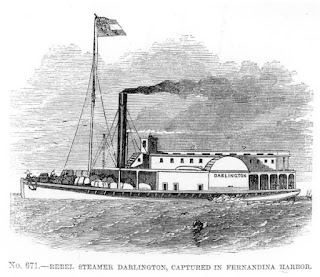Confederate steamboat Darlington, captured by Union forces near Fernandina and converted into a Union gunboat of the same name:
Here's a post to keep you tuned to Florida events as we transition from observing the Battle for New Orleans to the Battle of Drewry's Bluff.
The St. Johns River, running along the east coast of Florida, served as a main route of transportation for centuries. It was used by Native Americans, by French, Spanish and English colonists, and by the US after Florida became a state. As the northeast coast of Florida developed, the St. Johns was “the Interstate Highway” of the time. A thriving steamboat traffic developed on the river, transporting mail, freight and passengers from Jacksonville to Enterprise (near Lake Monroe), reaching a high point just prior to the start of the Civil War. After secession, many river steamboats (and their owners/captains) were converted into blockade runners, either running contraband goods between Florida and the Bahamas or “coastal blockade running” between ports in Florida, Georgia, and the Carolinas.
As Union forces occupied Fernandina, Florida, in March 1862, Commander C.R.P. Rogers pushed up a small creek near the town in a ship’s launch and captured the Confederate steamer Darlington, captained by Jacob Brock. Brock was a well-known steamboat captain on the St. Johns River prior to the war, who cast his lot with the Confederacy after Florida seceded. He initially refused commands to heave to, forcing the Union bluejackets to fire on the steamer, which eventually did stop and surrender. After boarding, the Union Navy officers were enraged, as there were a number of women and children aboard, who had been begging the captain to surrender as they were fired upon. Fortunately, no one was injured.
Capt. Jacob Brock, probably after the Civil War:
Perhaps in retaliation, Brock was arrested and sent to prison (even though he was not a member of the Confederate military), and his ship confiscated. In addition to the refugees, the steamer contained “military stores, and wagons, mules, forage, etc.” and a surgeon in the Confederate Army. The captured steamer was converted into the gunboat USS Darlington, and was a participant in an expedition up the St. Johns River in October 1862 (more on that to come this fall).
Another role played by the St. Johns River steamboats during the war was part of the “inside blockade running” (as described by George Buker in an article in “North and South” magazine, Vol. 4, No. 2). When the Union blockade closed down Fernandina, Jacksonville, and St. Augustine, blockade runners from the Bahamas ran their cargoes into Mosquito Inlet (present day Ponce De Leon Inlet, north of Cape Canaveral). The cargo was then transported overland by wagon or rail to points along the St. Johns River, where steamboats carried the goods to other rail points for shipment north to areas of the Confederacy where they were needed. Some of these steamboats were built by Mr. Hubbard Hart for his pre-war tours on the Ocklawaha River (a major tributary of the St. Johns River), which included the James Burt and the Silver Springs, along with Jacob Brock’s other boat, the Hattie.
After the war, Capt. Brock was paroled and was able to reacquire the Darlington and resume his occupation running steamboats on the St. Johns River. Mr. Hart resumed his Steamboat Line on the St. Johns and Ocklawaha Rivers, and many other entrepreneurs and industrialists rebuilt the steamboat trade on the St. Johns to its pre-war height. Robert E. Lee and Ulysses S. Grant both took trips on St. Johns River steamboats after the war. The rise and development of the railroads eventually doomed the river steamboats, and they faded into history by the mid-1900’s.
Steamboat Hattie at a wharf (possibly after the war). Illustration sources – Florida Dept. of State archives:
St. Johns River Steamboats in the Civil War
Info Post



0 comments:
Post a Comment